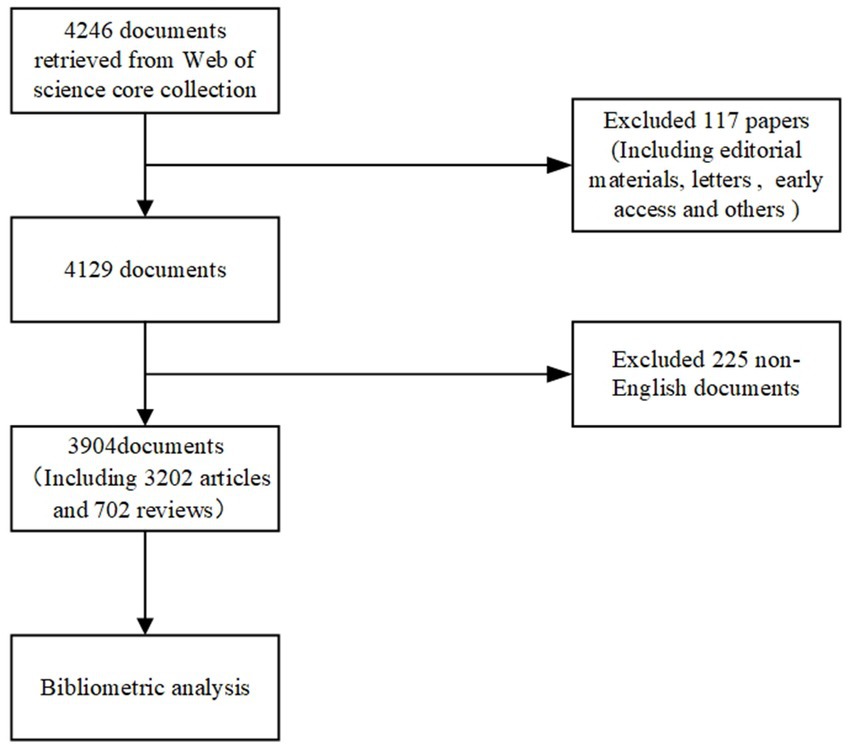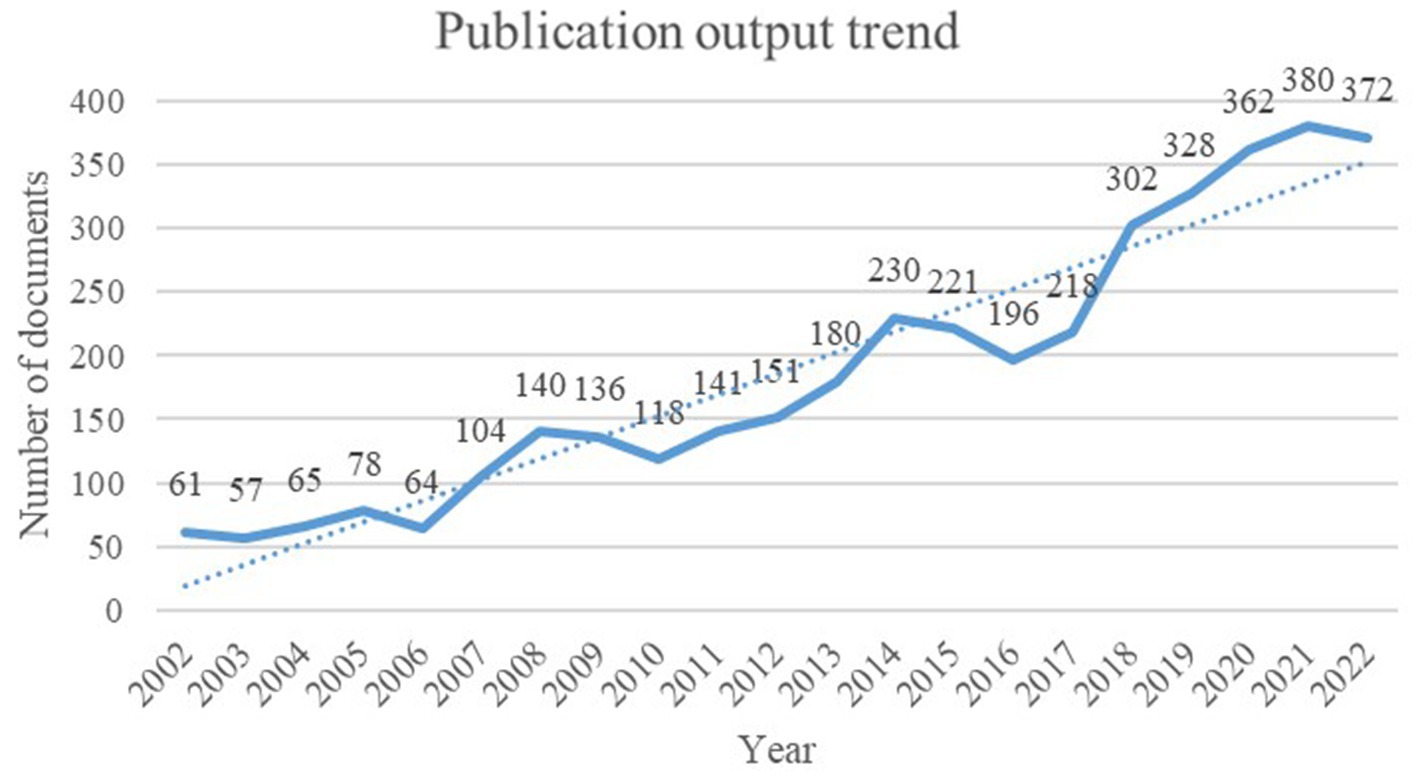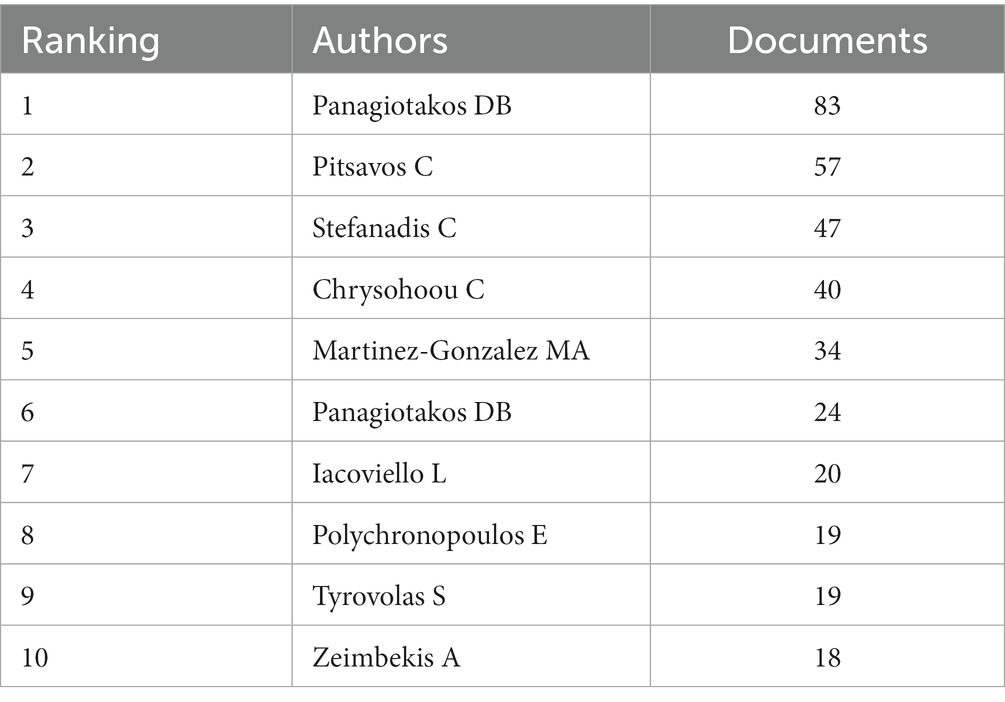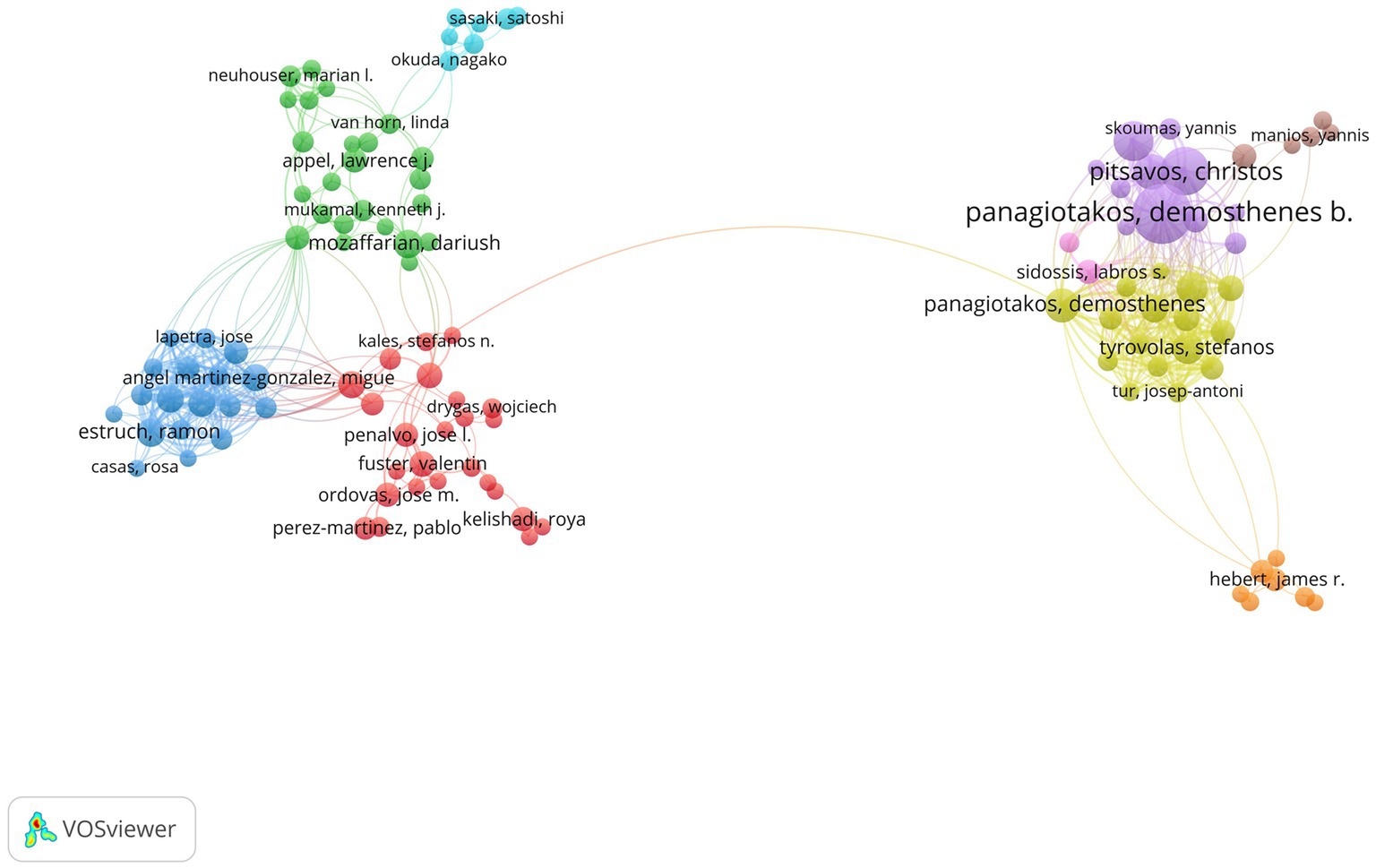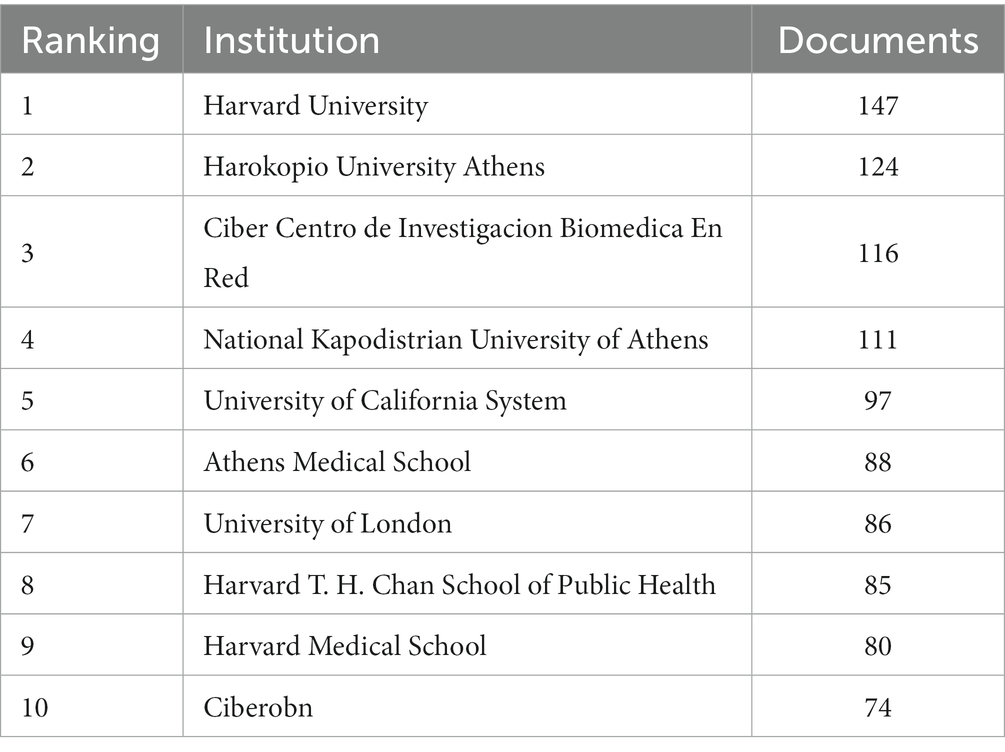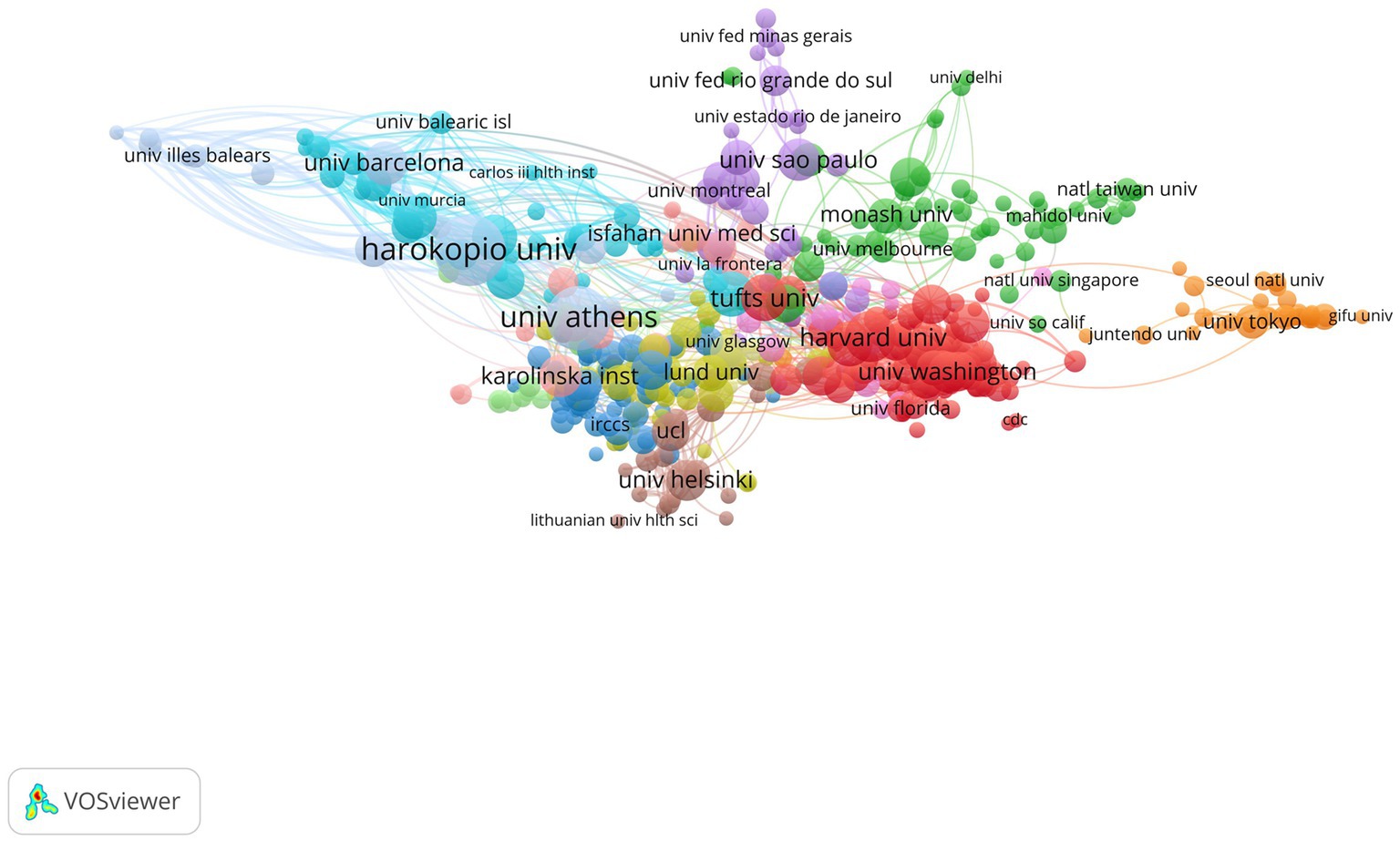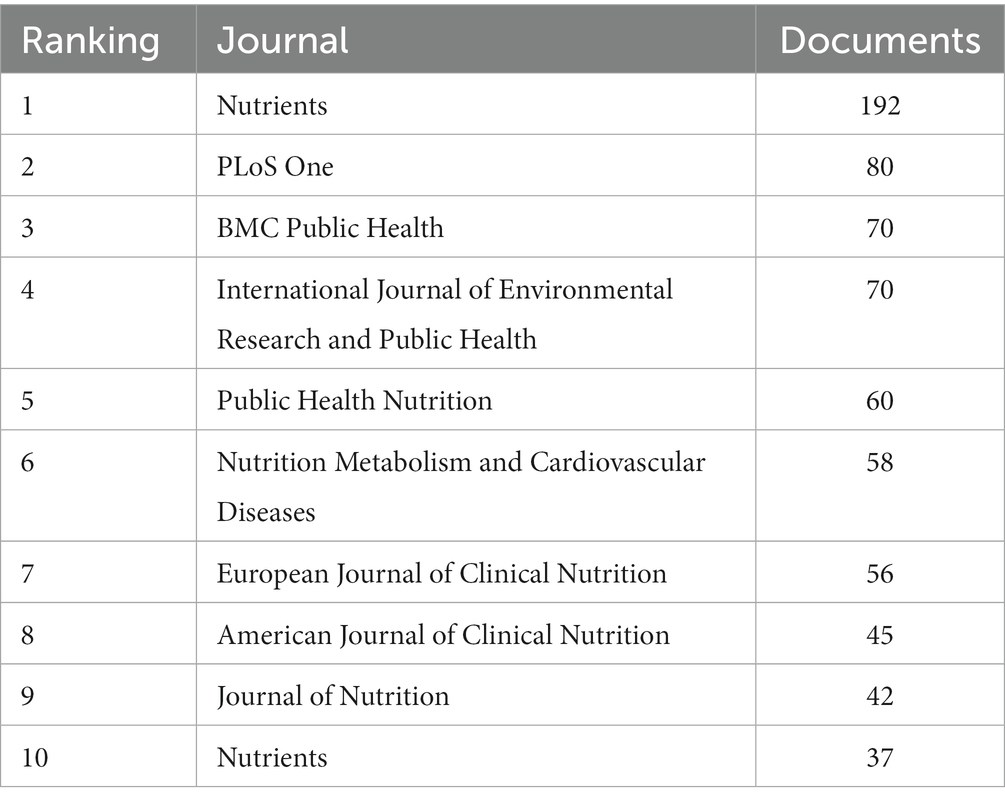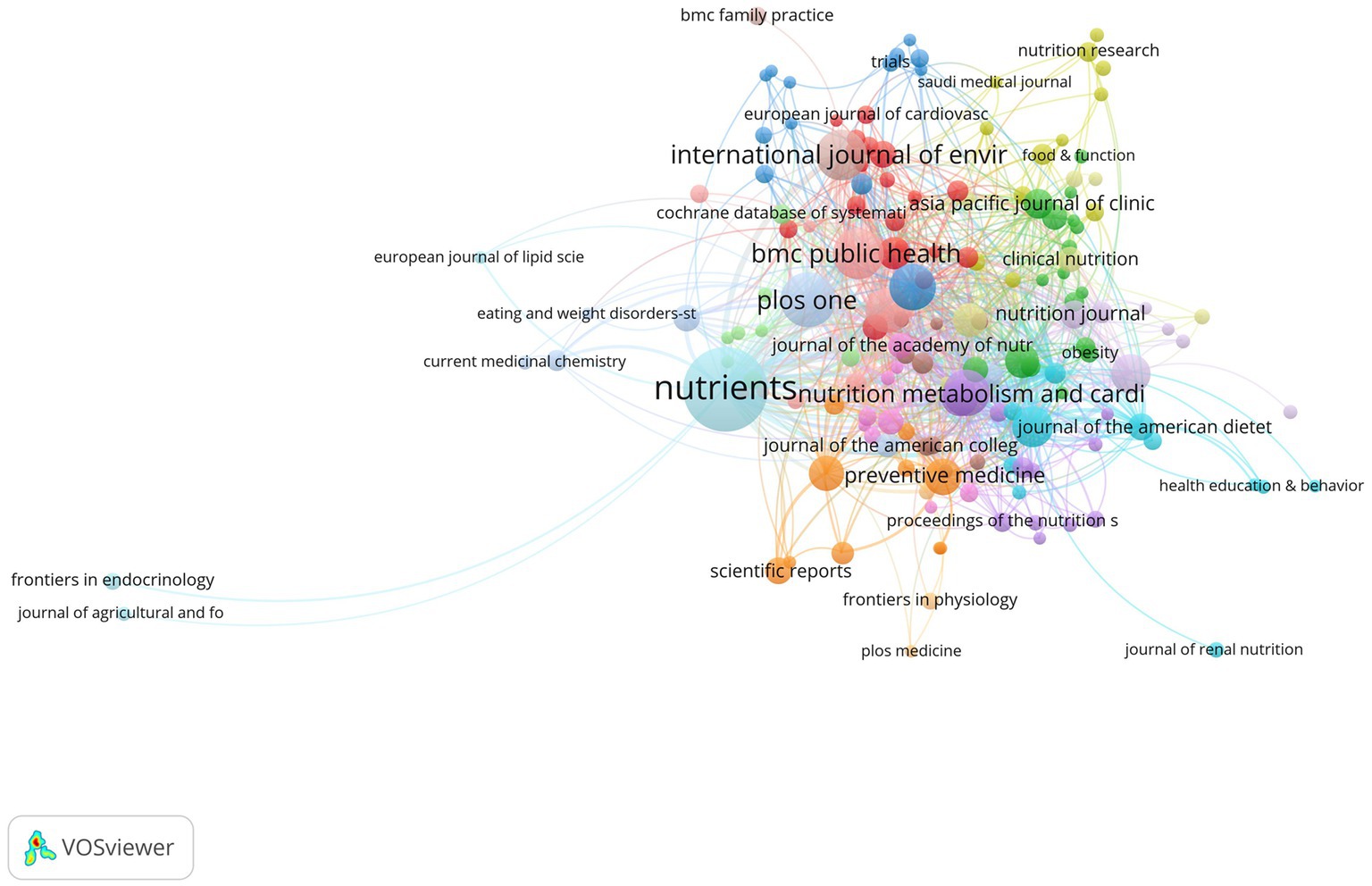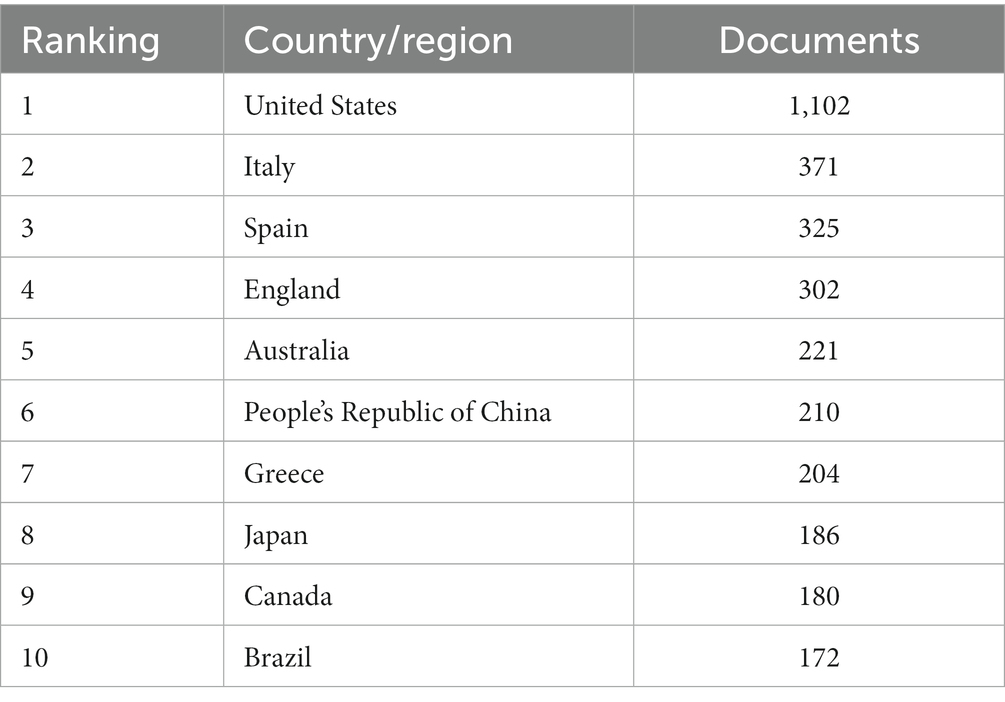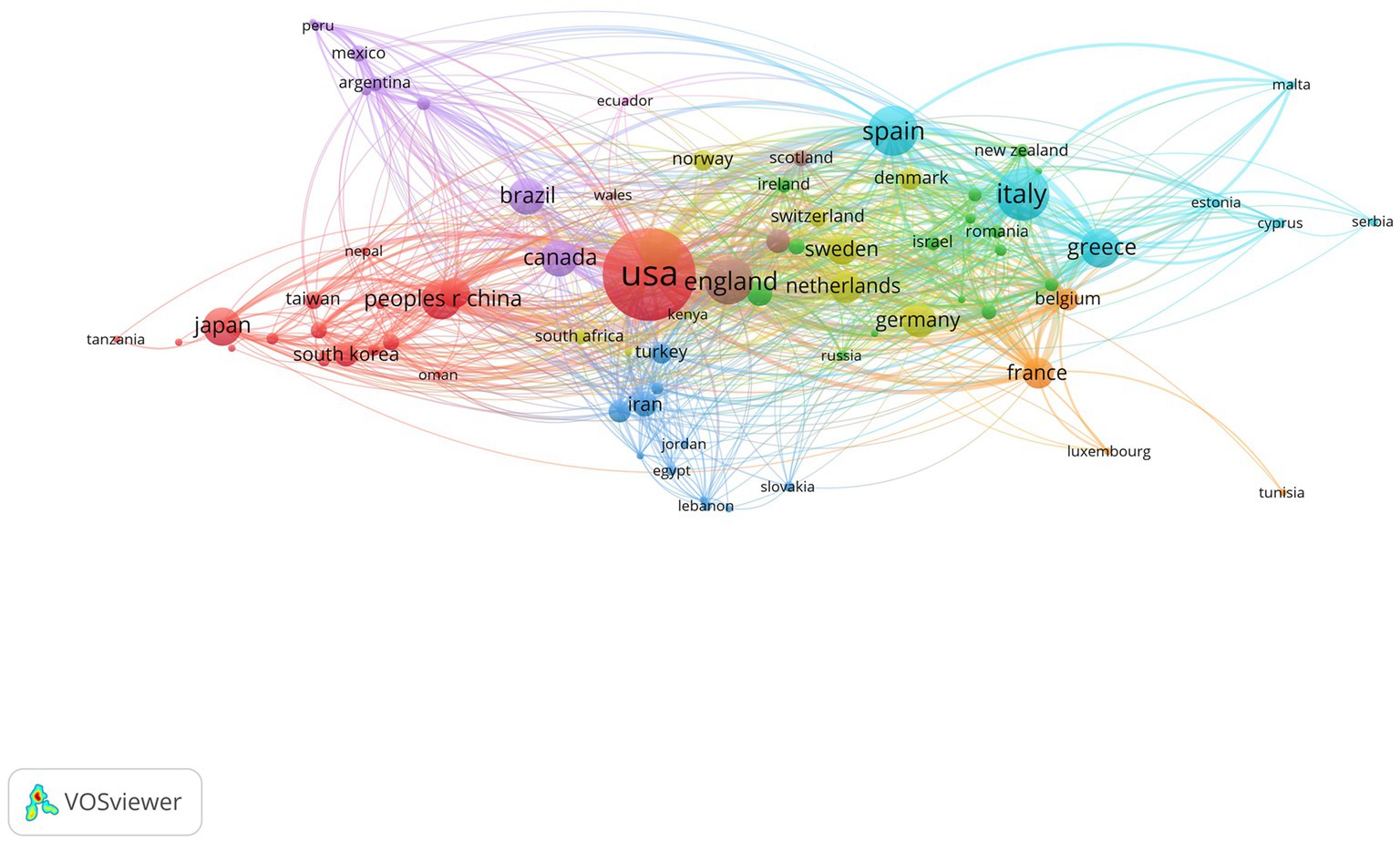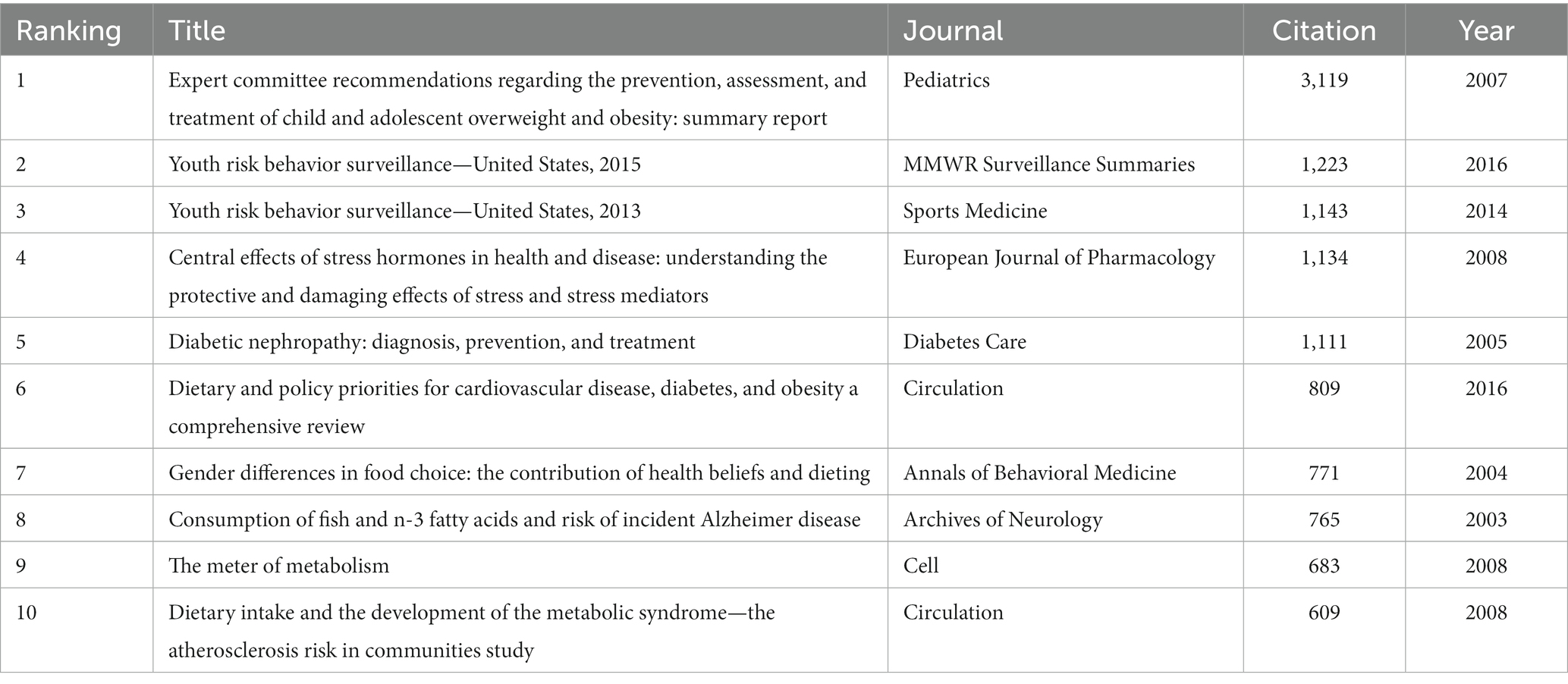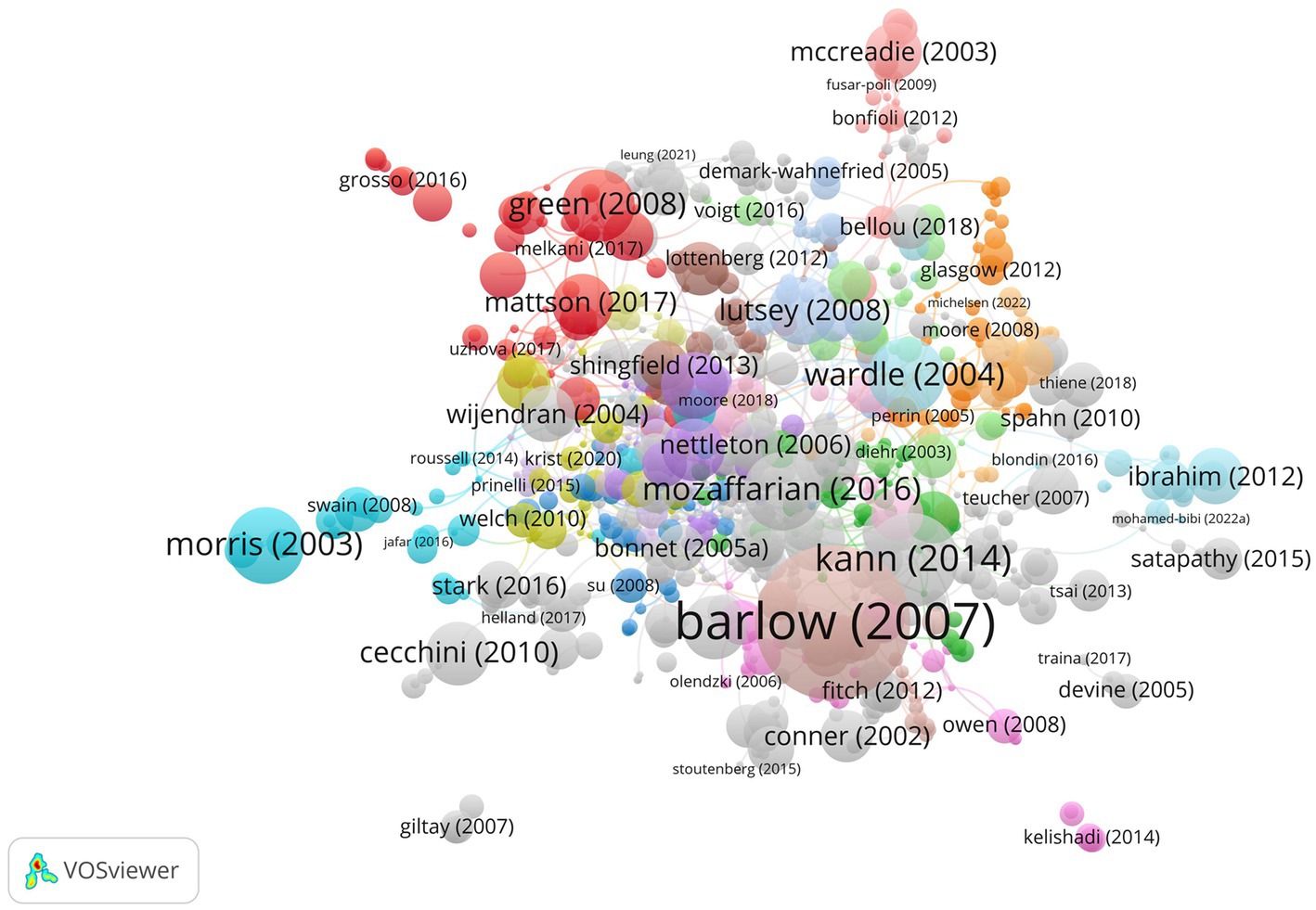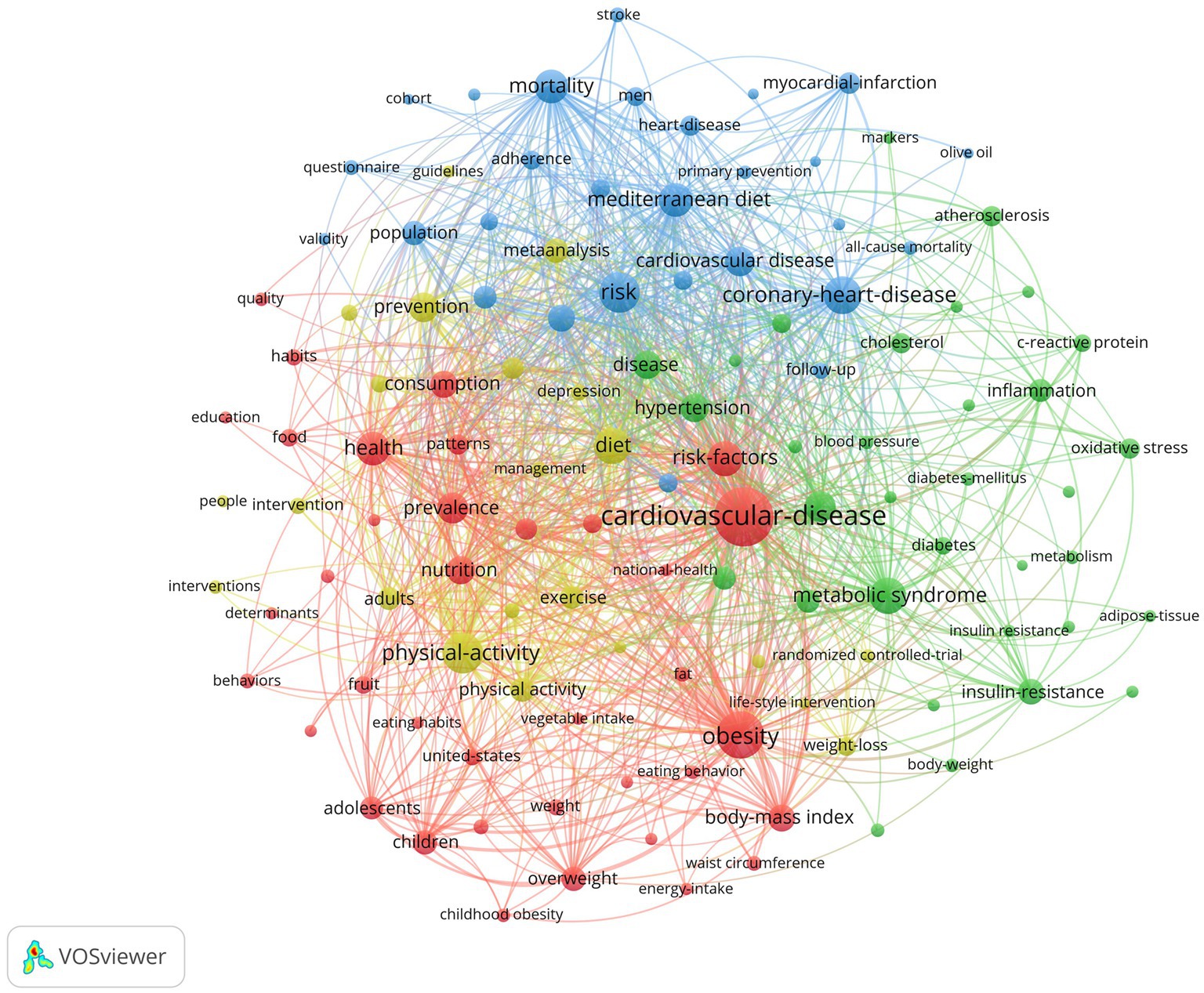- School of Health Preservation and Rehabilitation, Chengdu University of Traditional Chinese Medicine, Chengdu, China
Background: Dietary behaviors and cardiovascular disease are two major health issues that have attracted a lot of attention from researchers worldwide. In this study, we aimed to provide a comprehensive analysis of the publication trends, authorship patterns, institutional affiliations, country/region contributions, journal outlets, highly cited documents, and keyword clusters in the field of dietary behaviors and cardiovascular disease research over the past two decades.
Methods: We conducted a systematic literature review of peer-reviewed articles published from 2002 to 2022 in the Web of Science Core Collection database. We extracted and analyzed data on the annual publication volume, authorship patterns, institutional affiliations, country/region contributions, journal outlets, highly cited documents, and keyword clusters using bibliometric methods and visualization tools.
Results: Our study analyzed 3,904 articles, including 702 reviews and 3,202 research articles. The results revealed a continuous increase in the number of publications in this field over the past two decades. The top 10 authors, institutions, and countries/regions with the highest publication output were identified, indicating the leading contributors to this field. Moreover, the most frequently cited documents and highly clustered keywords were identified, providing insights into the research themes and topics in this field.
Conclusion: Our study provides a comprehensive analysis of the publication trends, authorship patterns, institutional affiliations, country/region contributions, journal outlets, highly cited documents, and keyword clusters in the field of dietary behaviors and cardiovascular disease research over the past two decades. The findings provide valuable information for researchers, policymakers, and stakeholders to understand the research landscape, identify research gaps, and develop future research directions in this field.
Introduction
Cardiovascular diseases (CVDs) continue to pose a significant global health burden, contributing to substantial morbidity and mortality worldwide (1). The prevalence of CVDs has reached epidemic proportions, warranting urgent attention and comprehensive strategies for prevention and management (2). Among the various modifiable risk factors associated with CVDs, dietary behaviors have emerged as crucial contributors to the development and progression of these conditions (3).
A growing body of evidence suggests that an individual’s dietary choices and patterns play a pivotal role in determining their cardiovascular health status (4). The intricate interplay between nutrients, bioactive compounds, and dietary components can significantly influence the pathophysiological processes underlying CVDs, including inflammation, oxidative stress, endothelial dysfunction, dyslipidemia, and hypertension (5–8). Furthermore, the impact of dietary factors extends beyond traditional risk factors, encompassing novel markers such as gut microbiota composition, metabolomic profiles, and epigenetic modifications, which further shape an individual’s cardiovascular risk profile (9–11).
Understanding the intricate relationship between dietary behaviors and cardiovascular health is essential for the development of effective preventive and therapeutic interventions (12). Moreover, unraveling the mechanisms underlying these associations can provide valuable insights into the etiology of CVDs and guide personalized dietary recommendations tailored to individuals at risk (13, 14). Additionally, exploring the cultural and social determinants that shape dietary behaviors is crucial for addressing health disparities and promoting equitable access to cardiovascular health (15).
Thus, this study aims to conduct a bibliometric analysis of studies examining dietary behavior and cardiovascular disease, published from 2002 to 2022, utilizing the Web of Science database. This study examines information on keywords, authors, institutions, countries/regions, and journals, employing VOSviewer to analyze the data. Ultimately, a deeper understanding of the intricate relationship between dietary behaviors and cardiovascular health can inform evidence-based strategies to promote heart health, empower individuals to make informed dietary choices, and alleviate the burden of cardiovascular diseases on a global scale.
Materials and methods
Data source
The research process is illustrated in Figure 1. We collected the data from the Web of Science Core Collection database. The timespan covered the last 21 years (from 2002 to 2022). The “topic” field was used to search for articles related to a specific research field. TS = (“behavior, feeding” or “feeding behaviors” or “eating behavior” or “behavior, eating” or “eating behaviors” or “feeding-related behavior” or “behavior, feeding-related” or “feeding related behavior” or “feeding-related behaviors” or “feeding patterns” or “feeding pattern” or “pattern, feeding” or “food habits” or “food habit” or “habit, food” or “eating habits” or “eating habit” or “habit, eating” or “dietary habits” or “dietary habit” or “habit, dietary” or “diet habits” or “diet habit” or “habit, diet” or “habits, diet”) and (“cardiovascular disease” or “disease, cardiovascular” or “cardiovascular diseases” or “diseases, cardiovascular”). The “document type” field was set to “article” and “review” to ensure that we only included articles in our analysis. The language of the included literature was limited to English in order to ensure consistency and minimize potential language bias.
Data analysis
We used VOSviewer, a bibliometric analysis software, to analyze the data. VOSviewer uses co-occurrence analysis to identify relationships between different terms and keywords in the articles. The software generates a map that shows clusters of related terms. The size of each term on the map indicates its importance and the thickness of the lines between the terms represents the strength of the relationship between them.
To generate the map, we first exported the search results from Web of Science Core Collection into a text file and then imported it into VOSviewer. We conducted keyword clustering analysis using the following parameters, with a minimum occurrence frequency set at 50 for each term to be included in the analysis. We used the VOSviewer default settings for the remaining parameters.
Data visualization
We used the VOSviewer software to generate the visualization of the co-occurrence analysis results. The visualization is presented in a map format, where each cluster of keywords is represented by a different color. The size of each keyword on the map is proportional to its frequency of occurrence in the articles, and the proximity of two keywords on the map indicates their degree of co-occurrence.
Results
Annual publication volume
In our study, we analyzed a total of 3,904 articles consisting of 702 reviews and 3,202 articles within the field of dietary behaviors and cardiovascular diseases. Our findings reveal that the number of publications in this area has been on the rise from 2002 to 2022. This trend is visually presented in Figure 2, which illustrates the number of publications related to dietary behaviors and cardiovascular research from 2002 to 2022.
Author analysis
From 2002 to 2022, a total of 20,640 authors have published documents in this field. Table 1 presents the top 10 authors ranked by the number of publications in the field of dietary behavior and cardiovascular disease. At the top of the list is Panagiotakos DB, who has published a remarkable 83 documents, indicating his significant contribution to the field. Pitsavos C follows closely behind with 57 publications, while Stefanadis C ranks third with 47 publications. Figure 3 shows the co-authorship of the authors.
Institutional analysis
In the past 21 years, a total of 5,244 research institutions have published papers in this field. Table 2 presents the top 10 institutions with the highest number of publications in the field of study. Harvard University leads the list with a remarkable 147 publications, followed closely by Harokopio University Athens with 124 publications. Ciber Centro de Investigacion Biomedica En Red ranks third with 116 publications, while National Kapodistrian University of Athens and University of California System round out the top five with 111 and 97 publications, respectively. The remaining institutions in the list include Athens Medical School, University of London, Harvard T. H. Chan School of Public Health, Harvard Medical School, and Ciberobn, all of which have made significant contributions to the field through their numerous publications. Figure 4 shows the co-authorship of institutions.
Journal analysis
A total of 1,301 journals have published papers related to the field. Table 3 presents the top 10 journals ranked by the number of publications in this field. The journal with the highest number of publications is Nutrients, with 192 papers. Following closely is PLoS One with 80 publications, and BMC Public Health and International Journal of Environmental Research and Public Health with 70 papers each. Other journals that made the top 10 list include Public Health Nutrition, Nutrition Metabolism and Cardiovascular Diseases, European Journal of Clinical Nutrition, American Journal of Clinical Nutrition, and Journal of Nutrition. The Figure 5 shows the visualization map of journal citations.
Country/regions analysis
In the past 21 years, a total of 121 countries/regions have published papers related to this field. Table 4 presents the top 10 countries/regions ranked by the number of publications in this field. The United States holds the leading position with 1,102 publications, followed by Italy with 371 publications and Spain with 325 publications. England, Australia, and People’s Republic of China also have a significant number of publications with 302, 221, and 210 documents, respectively. Greece, Japan, Canada, and Brazil are also among the top 10 countries/regions. Figure 6 shows the co-authorship of countries/regions.
Documents analysis
In the past 21 years, a total of 3,904 papers related to this field have been published. Table 5 shows the top 10 highly cited documents in the field. The expert committee recommendations regarding the prevention, assessment, and treatment of child and adolescent overweight and obesity: summary report, published in Pediatrics in 2007, ranked first with 3,119 citations. The report provides comprehensive recommendations on the prevention, assessment, and treatment of child and adolescent obesity, which is a major public health problem worldwide. The second most cited document is Youth Risk Behavior Surveillance—United States, 2015, published in MMWR Surveillance Summaries in 2016, with 1,223 citations. The document presents the results of a survey of risk behaviors among high school students in the United States, including behaviors related to obesity, physical activity, and nutrition. Ranked third is Youth Risk Behavior Surveillance—United States, 2013, published in Sports Medicine in 2014, with 1,143 citations. Similar to the second-ranked document, it reports on the results of a survey of risk behaviors among high school students in the United States. Figure 7 shows the visualization knowledge maps of highly cited documents.
Keyword analysis
There are a total of 12,855 keywords. Figure 8 illustrates the results of the keyword clustering analysis, where the keywords are categorized into four clusters represented by the colors red, blue, yellow, and green. The red cluster is dominated by keywords such as cardiovascular disease, obesity, body mass index, and overweight. The blue cluster includes keywords such as Mediterranean diet, heart disease, olive oil, mitochondrial dysfunction, stroke, and coronary heart disease. The yellow cluster is mainly composed of keywords such as diet, exercise, intervention, and prevention. The green cluster includes keywords such as oxidative stress, metabolic syndrome, insulin resistance, adipose tissue, blood pressure, cholesterol, inflammation, and C-reactive protein. This analysis provides a comprehensive understanding of the key themes and concepts in the field of diet and cardiovascular disease research.
Discussion
General information
This study analyzed the literature related to diet behavior and cardiovascular disease over the past 21 years, revealing a trend of increasing research output in this field. This suggests a growing interest among researchers and the general public in the link between diet behavior and cardiovascular health. Notably, Panagiotakos DB emerged as one of the most prolific authors in this field, having published 83 articles that highlight his significant contributions. Collaboration among authors also emerged as an important factor in advancing research in this area. Harvard University, Harokopio University Athens, and Ciber Centro de Investigacion Biomedica En Red were the top institutions in terms of research output, indicating their pivotal role in this field. Meanwhile, contributions from diverse institutions worldwide underscore the global reach of this research. The United States led the way in research output with 1,102 published articles, followed by Italy, Spain, England, Australia, and mainland China. This highlights the global nature of research in this field and the widespread interest among researchers worldwide. Nutrients, PLoS One, BMC Public Health, and International Journal of Environmental Research and Public Health were among the most prolific journals publishing in this field, covering a wide range of topics related to diet behavior and cardiovascular health. Keyword analysis revealed 12,855 keywords clustered into four groups represented by red, blue, yellow, and green. Red keywords included those related to cardiovascular disease, obesity, body mass index, and overweight. Blue keywords included Mediterranean diet, heart disease, olive oil, mitochondrial dysfunction, stroke, and coronary heart disease. Yellow keywords were related to diet, exercise, intervention, and prevention. Green keywords included oxidative stress, metabolic syndrome, insulin resistance, adipose tissue, blood pressure, cholesterol, inflammation, and C-reactive protein.
Research trends, knowledge gaps, and future directions
Taken together, these findings highlight the expanding scope of research on diet behavior and cardiovascular disease, encompassing a wide range of topics and concepts. Notable contributions from authors, institutions, and countries, such as Panagiotakos DB, Harvard University, and the United States, provide valuable insights for future research and practice to reduce the incidence of cardiovascular disease and promote public health.
Although the relationship between diet behavior and cardiovascular disease has been extensively studied, there are still some gaps that need to be further explored. One of these gaps is the impact of diet on the risk of cardiovascular disease in different races and cultural backgrounds. While some studies have suggested a correlation between dietary habits and the incidence of cardiovascular disease, most of these studies have focused on Western populations (16–18), and further research is needed for other ethnic and cultural groups. Another gap is the personalized design of dietary intervention measures. While some dietary intervention measures have been shown to improve the risk of cardiovascular disease (19–21), there is significant biological variation between individuals. Therefore, further research is needed to explore how to design personalized dietary intervention measures based on individual characteristics such as genes, metabolites, and microbiomes. Based on the trends and gaps in research, we can predict future research directions and focuses in this field. Firstly, we can expect to see more research on the relationship between dietary behavior and cardiovascular health in different cultural and geographical contexts. Another possible direction is the study of differences in dietary behavior and cardiovascular health between different individuals. This includes research on individuals of different genders, ages, ethnicities, and health statuses, as well as differences between dietary habits and nutrient requirements. Overall, we expect the research field of the relationship between dietary behavior and cardiovascular disease to continue to develop and expand, with future research focusing more on individual differences, the relationship between dietary patterns and nutrients, and the effects of food processing and cooking.
Strengths and limitations
In this study, a comprehensive analysis of publication trends, authorship patterns, institutional affiliations, country/region contributions, journal outlets, highly cited documents, and keyword clusters in the field of dietary behaviors and cardiovascular disease research over the past two decades was conducted. The use of systematic literature review and bibliometric methods ensured a rigorous and objective approach to analyzing the 3,904 articles included in the study, providing a representative sample of the research in this field. However, the limitations of this study include the reliance on articles from the Web of Science Core Collection database, which may not encompass all relevant publications, and the restriction to publications in English, which may limit generalizability to non-English speaking countries.
Conclusion
In conclusion, our analysis of the literature related to diet behavior and cardiovascular disease over the past 21 years reveals a trend of increasing research output in this field, indicating a growing interest among researchers and the general public. Notable contributions from authors, institutions, and countries provide valuable insights for future research and practice to reduce the incidence of cardiovascular disease and promote public health. However, there are still gaps in our understanding of the relationship between diet behavior and cardiovascular disease that need to be addressed in future research. We expect the research field in this area to continue to develop and expand, with a focus on individual differences, the relationship between dietary patterns and nutrients, and the effects of food processing and cooking.
Data availability statement
The raw data supporting the conclusions of this article will be made available by the authors, without undue reservation.
Author contributions
JW served as the first author and wrote the manuscript. QY contributed to the analysis and interpretation of the data and provided valuable insights during the manuscript writing process. NL and KN conducted the literature search and assisted in the drafting of the manuscript. XS provided valuable insights and expertise in data analysis, refining the research methodology. XS also played a crucial role in editing the manuscript to ensure clarity and coherence. LX as the corresponding author, reviewed and revised the manuscript and oversaw the overall process, providing guidance and coordination among the authors. All authors contributed to the article and approved the submitted version.
Funding
This work was financially supported by National Natural Science Foundation of China (82274384).
Conflict of interest
The authors declare that the research was conducted in the absence of any commercial or financial relationships that could be construed as a potential conflict of interest.
Publisher’s note
All claims expressed in this article are solely those of the authors and do not necessarily represent those of their affiliated organizations, or those of the publisher, the editors and the reviewers. Any product that may be evaluated in this article, or claim that may be made by its manufacturer, is not guaranteed or endorsed by the publisher.
References
1. AlAufi, NS, Chan, YM, Waly, MI, Chin, YS, Mohd Yusof, BN, and Ahmad, N. Application of Mediterranean diet in cardiovascular diseases and type 2 diabetes mellitus: motivations and challenges. Nutrients. (2022) 14:2777. doi: 10.3390/nu14132777
2. Cochrane Heart GroupRees, K, Al-Khudairy, L, Takeda, A, and Stranges, S. Vegan dietary pattern for the primary and secondary prevention of cardiovascular diseases. Cochrane Database Syst Rev. (2021) 2021:CD013501. doi: 10.1002/14651858.CD013501.pub2
3. Zhu, J, Xun, PC, Kolencik, M, Yang, KF, Fly, AD, and Kahe, K. Do B vitamins enhance the effect of omega-3 polyunsaturated fatty acids on cardiovascular diseases? A systematic review of clinical trials. Nutrients. (2022) 14:1608. doi: 10.3390/nu14081608
4. Whiteley, C, Benton, F, Matwiejczyk, L, and Luscombe-Marsh, N. Determining dietary patterns to recommend for type 2 diabetes: an umbrella review. Nutrients. (2023) 15:861. doi: 10.3390/nu15040861
5. Liang, S, Li, A, Mijatovic, J, Koemel, N, Nasir, R, Toniutti, C, et al. Dietary patterns and non-communicable disease biomarkers: a network meta-analysis and nutritional geometry approach. Nutrients. (2022) 15:76. doi: 10.3390/nu15010076
6. Kondo, K, Miura, K, Okamura, T, Okayama, A, and Ueshima, H. Dietary factors, dietary patterns, and cardiovascular disease risk in representative Japanese cohorts: NIPPON DATA80/90. J Atheroscler Thromb. (2023) 30:207–19. doi: 10.5551/jat.RV22001
7. Farazi, M, Jayedi, A, and Shab-Bidar, S. Dietary inflammatory index and the risk of non-communicable chronic disease and mortality: an umbrella review of meta-analyses of observational studies. Crit Rev Food Sci Nutr. (2023) 63:57–66. doi: 10.1080/10408398.2021.1943646
8. Liu, B, Chen, B, Guo, Y, and Tian, L. Acupuncture—a national heritage of China to the world: international clinical research advances from the past decade. Acupunct Herb Med. (2021) 1:65–73. doi: 10.1097/HM9.0000000000000017
9. Wang, LL, Wu, L, Qian, C, Ju, Y, Liu, T, Chen, Y, et al. The beneficial effect of a healthy dietary pattern on androgen deprivation therapy-related metabolic abnormalities in patients with prostate cancer: a meta-analysis based on randomized controlled trials and systematic review. Metabolites. (2022) 12:969. doi: 10.3390/metabo12100969
10. Storz, MA. What makes a plant-based diet? A review of current concepts and proposal for a standardized plant-based dietary intervention checklist. Eur J Clin Nutr. (2022) 76:789–800. doi: 10.1038/s41430-021-01023-z
11. Pressler, M, Devinsky, J, Duster, M, Lee, JH, Glick, CS, Wiener, S, et al. Dietary transitions and health outcomes in four populations—systematic review. Front Nutr. (2022) 9:748305. doi: 10.3389/fnut.2022.748305
12. Kazemi, M, Kim, JY, Wan, C, Xiong, JD, Michalak, J, Xavier, IB, et al. Comparison of dietary and physical activity behaviors in women with and without polycystic ovary syndrome: a systematic review and meta-analysis of 39 471 women. Hum Reprod Update. (2022) 28:910–55. doi: 10.1093/humupd/dmac023
13. Bochenek, H, Krga, I, Sergi, D, Kouvari, M, Zec, M, and Naumovski, N. Dietary patterns, caloric restrictions for management of cardiovascular disease and cancer; a brief review. Rev Cardiovasc Med. (2022) 23:1. doi: 10.31083/j.rcm2301041
14. Antoniazi, L, Arroyo-Olivares, R, Mata, P, and Santos, RD. Association of dietary patterns and components with atherosclerosis risk biomarkers in familial hypercholesterolemia. Curr Opin Lipidol. (2022) 33:89–94. doi: 10.1097/MOL.0000000000000813
15. Wu, PY, Chen, KM, and Belcastro, F. Dietary patterns and depression risk in older adults: systematic review and meta-analysis. Nutr Rev. (2021) 79:976–87. doi: 10.1093/nutrit/nuaa118
16. Uffelman, CN, Chan, NI, Davis, EM, Wang, Y, McGowan, BS, and Campbell, WW. An assessment of mushroom consumption on cardiometabolic disease risk factors and morbidities in humans: a systematic review. Nutrients. (2023) 15:1079. doi: 10.3390/nu15051079
17. Hassapidou, M, Vlassopoulos, A, Kalliostra, M, Govers, E, Mulrooney, H, Ells, L, et al. European association for the study of obesity position statement on medical nutrition therapy for the management of overweight and obesity in adults developed in collaboration with the European Federation of the Associations of Dietitians. Obes Facts. (2023) 16:11–28. doi: 10.1159/000528083
18. Nestel, PJ, and Mori, TA. Dietary patterns, dietary nutrients and cardiovascular disease. Rev Cardiovasc Med. (2022) 23:17. doi: 10.31083/j.rcm2301017
19. Liu, Y, Zhu, L, Li, D, Wang, L, Tang, H, and Zhang, C. Stroke risk with vegetarian, low-animal and high-animal diets: a systematic review and meta-analysis. Asia Pac J Clin Nutr. (2022) 31:422–32. doi: 10.6133/apjcn.202209_31(3).0010
20. Griffiths, A, Matu, J, Whyte, E, Akin-Nibosun, P, Clifford, T, Stevenson, E, et al. The Mediterranean dietary pattern for optimising health and performance in competitive athletes: a narrative review. Br J Nutr. (2022) 128:1285–98. doi: 10.1017/S0007114521003202
Keywords: dietary behavior, cardiovascular disease, bibliometric analysis, VOSviewer, visualization
Citation: Wang J, Yu Q, Liu N, Nie K, Sun X and Xia L (2023) Trends in research on dietary behavior and cardiovascular disease from 2002 to 2022: a bibliometric analysis. Front. Nutr. 10:1147994. doi: 10.3389/fnut.2023.1147994
Edited by:
Yong Zhao, Chongqing Medical University, ChinaReviewed by:
Leila Khorraminezhad, McGill University—Macdonald Campus, CanadaLijuan Zhao, Shanghai University of Traditional Chinese Medicine, China
Yihua Fan, First Teaching Hospital of Tianjin University of Traditional Chinese Medicine, China
Copyright © 2023 Wang, Yu, Liu, Nie, Sun and Xia. This is an open-access article distributed under the terms of the Creative Commons Attribution License (CC BY). The use, distribution or reproduction in other forums is permitted, provided the original author(s) and the copyright owner(s) are credited and that the original publication in this journal is cited, in accordance with accepted academic practice. No use, distribution or reproduction is permitted which does not comply with these terms.
*Correspondence: Lina Xia, eGlhbGluYUBjZHV0Y20uZWR1LmNu
 Jie Wang
Jie Wang Qingsong Yu
Qingsong Yu Lina Xia
Lina Xia